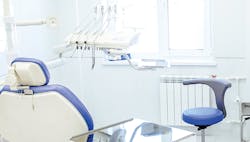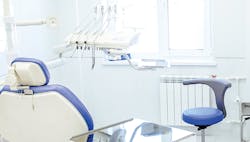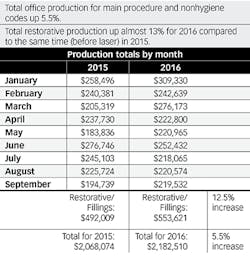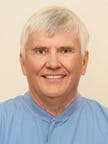Investing in the latest technology in the later years of practice
William Huntzinger, DDS
I graduated from Case Western Reserve Dental School in 1980 and completed my general practice residency in 1981 at St. Joseph’s Hospital in Syracuse, New York. I worked with another dentist for about a year before opening my own office in Swanton, Ohio. From the very beginning of my career, I invested in products and equipment that I believed would improve patient care while increasing profit.
As an eager adopter of technology, I learned very early in my career that embracing new technology drives patient care to new levels, increases production, and improves workflow. As soon as I completed my residency program, I purchased one of the first curing lights offered on the market, and I thought it was one of the best things ever made. Throughout the years there have been so many products that I’ve invested in, including an air abrasion system, rotary endo instruments, a diode and erbium laser, intraoral cameras, digital x-rays, a computerized tomography machine, a CariVu caries detection device (DEXIS), a CEREC chairside milling unit (Dentsply Sirona), and our latest tool for success purchased a year-and-a-half ago, the Solea 9.3 μm CO2 laser (Convergent Dental).
All of these investments have helped our practice go from one dentist (me), one front desk person, two assistants, and one hygienist in a three-operatory office to three offices, 10 dentists, and 52 staff members. Two locations are state-of-the-art, 12-operatory practices. The third is older, includes five operatories, and is currently undergoing renovation.
Our mission is to take advantage of the best technology available to grow and evolve. I also believe that if you have a positive mindset and provide superior patient care first, increased productivity and profitability will inevitably follow.
An example of return on investment (ROI) from investment in technology
Solea is an example of how investing in progressive technology not only benefits our patients but also our practice efficiency and profitability. It works on both hard and soft tissue, and in addition to allowing me to prepare teeth without anesthetic, it enables me to deliver blood-, suture-, and pain-free results to my patients. I’ve since experienced not only improved patient compliance, but dramatic gains in efficiency. I can perform multiquadrant dentistry, and can now offer procedures that we’ve typically referred out to specialists.
Moreover, my ROI has been truly significant. As you can see by our ROI chart (table 1), the numbers were so good in 2015–2016 that we now own four lasers—two in our Sylvania office, one in our Swanton office, and one that we will be putting in our third office location in Whitehouse, Ohio. We save lots of time since there’s no need for anesthesia. We don’t have to wait for patients to become numb, and there’s less time spent rescheduling appointments, because patients can feel their bite immediately after the procedure.
Table 1: ROI for Solea dental laser
For example, with Solea, I can work in multiple quadrants. I can perform a DO on Nos. 20, 29, and then go to Nos. 8 and 9 and do MLs on both of those, and then do a No. 25 facial—all without numbing the patient. This is a truly seamless new way of practicing dentistry. With subgingival restorations, I can just cut the tissue away and prep the tooth all at once without worrying about bleeding. There’s less blood, shorter healing time, and fewer complications.
My son practices with me and uses the laser without anesthetics on all of his pediatric patients and the majority of his adult restorative patients. He has almost 600 successful anesthetic-free cases under his belt. A lot of my patients are part of the “older” crowd, with amalgam and restorative materials used in past dental work. With Solea, I’m able to treat these patients without anesthesia.
Conclusion
I also own a dental consulting business, where I help people design dental offices. One of the things I’ve noticed is that many practice owners haven’t spent a dime to upgrade their businesses. They remain stagnant, never growing their practices, their offerings, or their patient bases. That way of thinking simply doesn’t work in our industry.
Our dental practice is probably in the top 5% of total incomes across the country, and I think keeping up with and investing in new technologies is a big part of it. It’s the natural progression. I’ve heard it all through the years: “Oh, I’m not going to buy a digital x-ray; it’s too expensive . . .” I have a 72-year-old dentist friend who remembers that when air-driven handpieces were first introduced, there were members of our profession who wondered if those newfangled high-speeds would really work. Well, we soon found out that they did. You can’t just sit there and do the same things you’ve been doing for years, never expanding your offerings or improving your services, because your practice will not grow or evolve.
I am 63 years old, and I love what I do. My plan is to continue to work into retirement years, but perhaps decrease my clinical hours and have my son take over the practice. We’re making decisions together.
I do believe that in addition to investing in new technologies, the other keys to success are having the right attitude, people skills, and, of course, clinical skills. You must also have a well-run office and the right people working with you who are willing to embrace what these new advances in dentistry are able to offer your practice and your patients.
William Huntzinger, DDS, practicing in Ohio since 1981, is a founding member of the International Academy of Mini Dental Implants. His interests are in cosmetic and implant dentistry and sleep apnea treatment. He is a member of the American Dental Association, Ohio Dental Association, Toledo Dental Society, Academy of General Dentistry, Academy of Sports Dentistry, Academy of Sleep Dentistry, and American Academy of Implant Dentistry.



